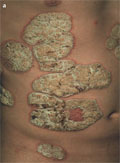The eLitMed.hu medical portal uses computer cookies for convenient operation. Detailed information can be found in the Cookie-policy.
Lege Artis Medicinae - 2008;18(02)
Content
[Pregnancy and insulin resistance: theoretical and clinical issues]
[During pregnancy, metabolic changes occur physiologically, which are enhanced by the presence of gestational or praegestational diabetes. The basis of these changes is the increasing insulin resistance throughout pregnancy, which in diabetics may result in hyperglycaemia with undesirable clinical consequences and complications. These complications can be prevented in diabetic pregnant women by maintaining the physiological metabolic state typical of healthy pregnant women. Thus the aim of the treatment is to achieve a normoglycaemic state throughout pregnancy. In most cases this is only possible by the use of insulin, along with appropriate dietary measures. Intensive insulin regimes are successfully used in the metabolic control of pregnant diabetic women, and the use of insulin analogues and insulin pump may also be considered.]
[PSORIASIS TODAY]
[Psoriasis is one of the most common dermatological disorders. It is an immune-mediated chronic inflammatory disease that primarily affects the skin and the joints, and substantially reduces the quality of life. It occurs worldwide, with a prevalence of about 2% in developed countries. Today numerous studies are continuously published on psoriasis. Important progress has been made especially on its genetics, pathomechanism and comorbidity. In the past few years, several efficient therapeutic approaches have been developed and applied. With the appearance of biological therapies, the inflammatory process can be targeted more selectively than before. The paper reviews most recent data on the pathogenesis, immunological background, comorbidity and reduced quality of life associated with psoriasis, and presents therapeutic approaches with special focus on recent advances. The increased knowledge allows of a more efficient treatment and care of patients with proriasis, thus significantly increasing their quality of life.]
[STATE-OF-THE ART COMPLEX TREATMENT OF THYROID CANCERS]
[Thyroid cancers derived from follicular epithelial cells are histologically classified as papillary, follicular and anaplastic. Cancers that originate from parafollicular, or C-cells, are termed medullary carcinomas. Their annual incidence is fairly low; 3 to 7 cases per 100 000 people. After the Chernobyl disaster, however, thyroid cancers have received much attention. They often occur at young age, and frequently and early give metastases. They typically grow slowly and have a good prognosis even in the metastatic stage. The main prognostic factors include age, tumour size and extent, the completeness of surgical removal, distant metastases and tumour grade. Based on these parameters, they are classified into high-risk and low-risk groups. There are no prospective randomized studies available on the optimal treatment of thyroid cancers. Their biological aggressiveness differs according to geographic location, which explaines why the management of thyroid carcinomas has not been standardized internationally. Contrary to America and Australia, in Europe there are several endemic goitre regions, and background radiation is higher. It is generally accepted that here the standard therapy of choice is total thyreoidectomy with adequate lymph node dissection followed by postoperative radioiodine ablation. It is a reasonable demand to minimize the higher morbidity associated with radical surgery (e.g., recurrent nerve palsy, postoperative hypoparathyroidism) below 1%. It is recommended that such operations are performed by experienced thyroid surgeons in centres with multidisciplinary endocrine teams.]
[MODERN TREATMENT OF COLORECTAL CANCER]
[The incidence of colorectal cancer has dramatically increased in the past decades, rendering it the second most frequently diagnosed cancer in the Western world. Disease outcome can be improved both by early diagnosis, e.g., through the introduction and extension of screening programs, and by increased therapeutic efficiency. The latter is achieved by increasing the radicality of interventions in surgical oncology to total mesorectal excision, thereby significantly decreasing the frequency of local recurrence. High ligation of the inferior mesenteric artery aims to enhance the efficiency of lymphadenectomy. With the introduction of techniques that spare vegetative nerves, the quality of life will not be adversely affected by the increased radicality. Another direction of progress in colorectal surgery is the increased use of minimally invasive approaches, such as local excision by transanal endoscopic microsurgery or laparoscopic methods. Increased acceptance of a multimodality approach, i.e., combined application of surgical and oncological methods in the treatment of colorectal cancer, has been a great step forward recently. Beyond the long-applied adjuvant treatments, the pre-surgical use of neoadjuvant chemo-radiotherapy has become standard for locally advanced rectal cancers. Adjuvant and neoadjuvant chemotherapy also supplements the surgery of metastases with improving results and impressive long-term survivals. A very important prerequisite for tailored multimodality treatment is reliable staging, which is facilitated by the wider availability of endorectal ultrasound.]
[Management of bleeding from oesophageal and gastric varices]
[INTRODUCTION – Variceal haemorrhage from the oesophageal or gastric wall is a major cause of death in patients with chronic liver disease. Over the past two decades many new treatment modalities have been introduced in the management of variceal bleeding, such as emergency endoscopy, band ligation and postintervention observation of the bleeding patients in subintensive care units. This study presents the results of state-of-the-art therapy applied in our department, comparing them to published data. PATIENTS AND METHODS – Clinical records of patients with variceal haemorrhage admitted to our department between January 1st 2001 and December 31st 2004 were reviewed. Six-week mortality, incidence of recurrent bleeding, transfusion requirement and length of hospital stay were the main parameters analysed. RESULTS – A total of 228 admissions (191 patients) due to variceal bleeding were recorded in the study period. Cirrhosis was of alcoholic origin in 92% of patients. Upper endoscopy was performed in 94% of patients within 4 hours and endoscopic therapy was also applied in all but 7 patients. Octreotide was administered in 4 patients, and portosystemic shunt was performed in 1 patient. Primary endoscopic haemostasis was achieved in 85% of cases, while rebleeding rate was 31%. The mean length of total hospital stay was 10.6 days, including an average of 2.6 days in subintensive care units. The mean transfusion requirement was 3.75 units of packed red cells. Six-week mortality rate was 14.9%. CONCLUSION – In comparison to international data, the six-week mortality rate among our patients was substantially lower than that in earlier reports, and nearly equals with recent leading results.]
[LEIOMYOSARCOMA OF THE INFERIOR VENA CAVA: CASE REPORT]
[INTRODUCTION - Primary neoplasm of the great blood vessels is rarely reported. The tumour most commonly presents in the inferior vena cava. In general, the prognosis is very poor, since intimal sarcomas metastasise early, and mural sarcomas grow silently and remain hidden for a long time. Also, because this type of tumour is so uncommon, it is often not considered for diagnosis. CASE REPORT - We report on the case of a 77- year-old woman with progressive symmetric oedema of the lower limbs. The investigations revealed a tumour thrombus that obliterated the inferior vena cava in its entire length. No surgery was possible because of the advanced stage of the disease. Later, Budd-Chiari syndrome developed and the patient died of progressive hepatic failure. The tumour was initially thought to be that of extravascular origin breaking into the vein. However, autopsy revealed a primary tumour of vascular origin, which histologically proved to be a leiomyosarcoma. CONCLUSION - Today, the recognition of the insidiously growing vascular mural sarcomas is assisted by an entire diagnostic arsenal. It is important, however, that the possibility of this rare disease is considered in time to permit surgical removal, the only treatment that can prolong survival. The authors would like to contribute to this by presenting this rare clinical case.]
1.
Clinical Neuroscience
[Headache registry in Szeged: Experiences regarding to migraine patients]2.
Clinical Neuroscience
[The new target population of stroke awareness campaign: Kindergarten students ]3.
Clinical Neuroscience
Is there any difference in mortality rates of atrial fibrillation detected before or after ischemic stroke?4.
Clinical Neuroscience
Factors influencing the level of stigma in Parkinson’s disease in western Turkey5.
Clinical Neuroscience
[The effects of demographic and clinical factors on the severity of poststroke aphasia]1.
2.
Clinical Oncology
[Pancreatic cancer: ESMO Clinical Practice Guideline for diagnosis, treatment and follow-up]3.
Clinical Oncology
[Pharmacovigilance landscape – Lessons from the past and opportunities for future]4.
5.






















